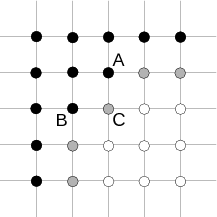|
|
|
|
A robust approach to time-to-depth conversion and interval velocity estimation from time migration in the presence of lateral velocity variations |
Below we outline the steps involved in computing one linearization update:
First, we apply the fast-marching method (Sethian, 1999; Sethian and Popovici, 1999) to solve the eikonal equation
6 by initializing a plane-wave source at ![]() . Computation for
. Computation for ![]() can be incorporated into
can be incorporated into ![]() by adopting the upwind finite-differences of
by adopting the upwind finite-differences of ![]() for equation 7. In Figure 2, consider
a currently updated grid point
for equation 7. In Figure 2, consider
a currently updated grid point ![]() during forward modeling of
during forward modeling of ![]() . If it has only one upwind neighbor
. If it has only one upwind neighbor ![]() that
is inside the wave-front,
that
is inside the wave-front,
![]() , then the image ray must be aligned with grid segment
, then the image ray must be aligned with grid segment ![]() and
therefore
and
therefore
![]() . We refer to this scenario as one-sided. If
. We refer to this scenario as one-sided. If ![]() has two upwind neighbors
has two upwind neighbors ![]() and
and ![]() ,
,
![]() , and they are both inside the wave-front, then the image
ray must intersect the simplex
, and they are both inside the wave-front, then the image
ray must intersect the simplex ![]() from an angle. In this case, we compute
from an angle. In this case, we compute ![]() from
from

|
|---|
|
fmm
Figure 2. A modified fast-marching method for forward modeling. Black dots represent region that has been swept by the wave-front, gray dots are the expanding wave-front and grid points being updated, and white dots are region yet to be reached. |
|
|
Because ![]() at certain grid points is calculated by one-sided scenario,
at certain grid points is calculated by one-sided scenario,
![]() there
contains all zeros. Consequently, an evaluation of the cost
there
contains all zeros. Consequently, an evaluation of the cost ![]() at these locations with
at these locations with
![]() becomes inaccurate. We exclude these regions from
becomes inaccurate. We exclude these regions from ![]() and expect
inversion to fill them.
and expect
inversion to fill them.
Next, we apply simple bilinear interpolation for ![]() and estimate
and estimate
![]() by
solving equation 13 using shaping regularization (Fomel, 2007). We use a
triangular smoother with adjustable size as the shaping operator. We find in numerical tests that shaping
significantly improves convergence speed compared to that of the traditional Tikhonov
regularization (Tikhonov, 1963) with gradient operators. We also observe that without regularization the
model update can be undesirably oscillatory. We believe this phenomenon is related to the ill-posedness of
the PDEs.
by
solving equation 13 using shaping regularization (Fomel, 2007). We use a
triangular smoother with adjustable size as the shaping operator. We find in numerical tests that shaping
significantly improves convergence speed compared to that of the traditional Tikhonov
regularization (Tikhonov, 1963) with gradient operators. We also observe that without regularization the
model update can be undesirably oscillatory. We believe this phenomenon is related to the ill-posedness of
the PDEs.
Finally, we reduce computational cost by adopting the method of
conjugate gradients (Hestenes and Stiefel, 1952) and an efficient implementation of ![]() , as well as its
adjoint, according to the equations derived in Appendix B. For this purpose, we choose the upwind
finite-difference scheme (Li et al., 2011; Franklin and Harris, 2001) based on
, as well as its
adjoint, according to the equations derived in Appendix B. For this purpose, we choose the upwind
finite-difference scheme (Li et al., 2011; Franklin and Harris, 2001) based on
![]() for both
for both
![]() and
and
![]() . As shown by Li et al. (2013), applying
. As shown by Li et al. (2013), applying
![]() and its transpose involves only sparse triangularized matrix-vector multiplications and
is therefore inexpensive. For example, at each grid point
and its transpose involves only sparse triangularized matrix-vector multiplications and
is therefore inexpensive. For example, at each grid point
![]() relies on only its
upwind neighbors. The computational complexity of
relies on only its
upwind neighbors. The computational complexity of ![]() and
and ![]() is
is ![]() , where
, where
![]() is the total number of grid points.
is the total number of grid points.
|
|
|
|
A robust approach to time-to-depth conversion and interval velocity estimation from time migration in the presence of lateral velocity variations |